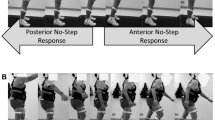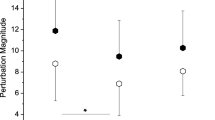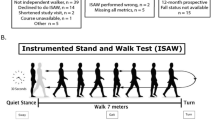Abstract
Background and aims: Stepping reactions play a critical role in responding to balance perturbations, whether they are a consequence of external perturbation or self-induced in nature. The aim of the present study was to determine prospectively the capacity of voluntary stepping performance in singleand dual-task conditions, to predict future falls among older community-dwelling persons. We also aimed to assess whether dual task conditions have an added value over single tasks for fall prediction. Methods: A total of 100 healthy old volunteers (mean age 78.4±5.7 yrs), from two self-care protected retirement homes for older adults, performed the Voluntary Step Execution Test in single- and dual-task conditions as a reaction time task while standing on a single force platform. Step initiation, preparatory and swing phases, and foot-contact time were extracted from data on center of pressure and ground reaction force. One-year fall incidences were monitored. Results: Ninety-eight subjects completed the one-year follow-up, 49 non-fallers, 32 one-time fallers, and 17 recurrent fallers (two or more falls). Recurrent fallers had significantly slower voluntary step execution times in both single- and dual-task conditions, especially due to a slower preparation phase. Two stepwise (backward) logistic regression models showed that longer step execution times have strong predictive value for falls in both single- and dual-task conditions (odds ratio (OR) 8.7 and 5.4, respectively, p<0.05). Conclusions: Voluntary Step Execution Test in both single- and dual-task conditions is a simple and safe examination which can potentially and effectively predict future falls, with no added value to dual- over single-task condition.
Similar content being viewed by others
References
Centers for Disease Control and Prevention (CDC): Fatalities and injuries from falls among older adults—United States, 1993–2003 and 2001–2005. MMWR Morb Mortal Wkly Rep 2006; 55: 1221–4. Available at: http://www.cdc.gov/mmwr/preview/ mmwrhtml/mm5545a1.htm Accessed.
Holmberg AH, Johnell O, Nilsson PM, Nilsson JA, Berglund G, Akesson K. Risk factors for hip fractures in a middle-aged population: a study of 33,000 men and women. Osteoporos Int 2005; 16: 2185–94.
King MB, Tinetti ME. A multifactorial approach to reducing injurious falls. Clin Geriatr Med 1996; 12: 745–59.
Guralnick JM, Simonsick EM, Ferrucci L et al. A short physical performance battery assessing lower extremity function: association with self-reported disability and prediction of mortality and nursing home admission. J Gerontol 1994; 49: 85–94.
Maki BE, McIlroy WE. Control of compensatory stepping reactions: age-related impairment and the potential for remedial intervention. Physiother Theory Pract 1999; 15: 69–90.
Melzer I, Oddsson LIE. The effect of a cognitive task on voluntary step execution in healthy elderly individuals. J Am Geriatr Soc 2004; 52: 1255–62.
Zijlstra A, Ufkes T, Skelton DA, Lundin-Olsson L, Zijlstra W. Do dual tasks have an added value over single tasks for balance assessment in fall prevention programs? A mini-review. Gerontology 2008; 54: 40–9.
Melzer I, Kurtz I, Shahar D, Levi M, Oddsson L. Application of the voluntary step execution test to identify elderly fallers. Age Ageing 2007; 36: 532–7.
Rogers MW, Hedman LD, Johnson ME, Cain TD, Hanke TA. Lateral stability during forward-induced stepping for dynamic balance recovery in young and older adults. J Gerontol A Biol Sci Med Sci 2001; 56: 589–94.
Maki BE, McIlroy WE. Control of rapid limb movements for balance recovery: age-related changes and implications for fall prevention. Age Ageing 2006; 35 (Suppl 2): ii12–8.
Hilliard MJ, Martinez KM, Janssen I et al. Lateral balance factors predict future falls in community-living older adults. Arch Phys Med Rehabil 2008; 89: 1708–13.
Hsiao-Wecksler ET, Robinovitch SN. The effect of step length on young and elderly women’s ability to recover balance. Clin Biomech (Bristol, Avon) 2007; 22: 574–80.
Medell JL, Alexander NB. A clinical measure of maximal and rapid stepping in older women. J Gerontol A Biol Sci Med Sci 2000; 55: 429–33.
Lindemann U, Lundin-Olsson L, Hauer K, Wengert M, Becker C, Pfeiffer K. Maximum step length as a potential screening tool for falls in non-disabled older adults living in the community. Aging Clin Exp Res 2008; 20: 394–9.
Lord SR, Fitzpatrick RC. Choice stepping reaction time: a composite measure of falls risk in older people. J Gerontol A Biol Sci Med Sci 2001; 56: 627–32.
St George RJ, Fitzpatrick RC, Rogers MW, Lord SR. Choice stepping response and transfer times: effects of age, fall risk, and secondary tasks. J Gerontol A Biol Sci Med Sci 2007; 62: 537–42.
Siu KC, Lugade V, Chou LS, van Donkelaar P, Woollacott MH. Dual-task interference during obstacle clearance in healthy and balance-impaired older adults. Aging Clin Exp Res 2008; 20: 349–54.
Springer S, Giladi N, Peretz C, Yogev G, Simon ES, Hausdorff JM. Dual-tasking effects on gait variability: the role of aging, falls, and executive function. Mov Disord 2006; 21: 950–7.
Kressig RW, Herrmann FR, Grandjean R, Michel JP, Beauchet O. Gait variability while dual-tasking: fall predictor in older inpatients? Aging Clin Exp Res 2008; 20: 123–30.
Tinetti ME, Speechley M, Ginter SF. Risk factors for falls among elderly persons living in the community. N Engl J Med 1988; 319: 1701–7.
Berg, KO, Wood-Dauphinée SL, Williams JI, Gayton D. Measuring balance in the elderly: preliminary development of an instrument. Physiotherapy Canada 1989; 41: 304–11.
Guidelines for the Prevention of Falls in Older Persons. American Geriatrics Society, British Geriatrics Society, and American Academy of Orthopaedic Surgeons Panel on Falls Prevention. J Am Geriatr Soc 2001; 49: 664–72.
Lundin-Olsson L, Jensen J, Nyberg L, Gustafson Y. Predicting falls in residential care by a risk assessment tool, staff judgement, and history of falls. Aging Clin Exp Res 2003; 15: 51–9.
Rogers MW, Pai YC. Dynamic transitions in stance support accompanying leg flexion movements in man. Exp Brain Res 1990; 81: 398–402.
Michel-Pellegrino V, Hewson D, Hogrel JY, Duchêne J. Stepping down backwards as a means of detecting biomechanical differences between healthy older and younger adults. Aging Clin Exp Res 2008; 20: 226–33.
Rogers MW, Mille ML. Lateral stability and falls in older people. Exerc Sport Sci Rev 2003; 31: 182–7.
Kerrigan DC, Todd MK, Della Croce U, Lipsitz LA, Collins JJ. Biomechanical gait alterations independent of speed in the healthy elderly: evidence for specific limiting impairments. Arch Phys Med Rehabil 1998; 79: 317–22.
Shumway-Cook A, Brauer S, Woollacott M. Predicting the probability for falls in community-dwelling older adults using the Timed Up and Go Test. Phys Ther 2000; 80: 896–903.
Dibble LE, Lange M. Predicting falls in individuals with Parkinson disease: a reconsideration of clinical balance measures. J Neurol Phys Ther 2006; 30: 60–7.
Condron JE, Hill KD. Reliability and validity of a dual-task force platform assessment of balance performance: effect of age, balance impairment, and cognitive task. J Am Geriatr Soc 2002; 50: 157–62.
Ashburn A, Stack E, Pickering RM, Ward CD. Predicting fallers in a community-based sample of people with Parkinson’s disease. Gerontology 2001; 47: 277–81.
Bergland A, Wyller TB. Risk factors for serious fall related injury in elderly women living at home. Inj Prev 2004; 10: 308–13.
Verghese J, Buschke H, Viola L et al. Validity of divided attention tasks in predicting falls in older individuals: a preliminary study. J Am Geriatr Soc 2002; 50: 1572–6.
Melzer I, Kurtz I, Shahar D, Levi M, Oddsson LIE. Predicting falls in the elderly: comparison of voluntary step reaction times in fallers and non-fallers. A Prospective Study. J Am Geriatr Soc 2009; 57: 743–5.
Huxhold O, Li SC, Schmiedek F, Lindenberger U. Dual-tasking postural control: aging and the effects of cognitive demand in conjunction with focus of attention. Brain Res Bull 2006; 69: 294–305.
Bloem BR, Valkenburg VV, Slabbekoorn M, Willemsen MD. The Multiple Tasks Test: development and normal strategies. Gait Posture 2001; 14: 191–202.
Author information
Authors and Affiliations
Corresponding author
Rights and permissions
About this article
Cite this article
Melzer, I., Kurz, I., Shahar, D. et al. Do voluntary step reactions in dual task conditions have an added value over single task for fall prediction? A prospective study. Aging Clin Exp Res 22, 360–366 (2010). https://doi.org/10.1007/BF03324940
Received:
Accepted:
Published:
Issue Date:
DOI: https://doi.org/10.1007/BF03324940




